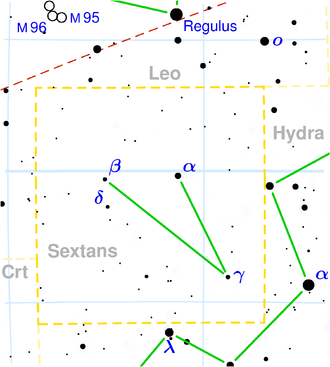NGC 3015
| Galaxie NGC 3015 | |
|---|---|
 | |
| NGC 3015 & LEDA 213639[1], SDSS-Aufnahme | |
| AladinLite | |
| Sternbild | Sextant |
| Position Äquinoktium: J2000.0, Epoche: J2000.0 | |
| Rektaszension | 09h 49m 22,9s[2] |
| Deklination | +01° 08′ 44″[2] |
| Erscheinungsbild | |
| Morphologischer Typ | SAB0^0^ / NLAGN SABbc?[2] |
| Helligkeit (visuell) | 13,5 mag[3] |
| Helligkeit (B-Band) | 14,5 mag[3] |
| Winkelausdehnung | 0,5′ × 0,4′[3] |
| Positionswinkel | 95°[3] |
| Flächenhelligkeit | 11.6 mag/arcmin²[3] |
| Physikalische Daten | |
| Zugehörigkeit | WBL 234[2] |
| Rotverschiebung | 0.025017 0.000073[2] |
| Radialgeschwindigkeit | (7500 ± 22) km/s[2] |
| Hubbledistanz vrad / H0 | (328 ± 23) · 106 Lj (100,7 ± 7,1) Mpc [2] |
| Durchmesser | 45.000 Lj |
| Geschichte | |
| Entdeckung | Albert Marth |
| Entdeckungsdatum | 23. April 1864 |
| Katalogbezeichnungen | |
| NGC 3015 • UGC 5261 • PGC 28240 • CGCG 007-041 • MCG +00-25-020 • IRAS 09468+0122 • 2MASX J09492289+0108437 • GALEXASC J094922.93+010842.8 | |
NGC 3015 ist eine Linsenförmige Galaxie mit aktivem Galaxienkern vom Hubble-Typ SB0-a im Sternbild Sextant am Südsternhimmel. Sie ist schätzungsweise 328 Millionen Lichtjahre von der Milchstraße entfernt und hat einen Durchmesser von etwa 45.000 Lj.
Im selben Himmelsareal befinden sich u. a. die Galaxien NGC 3018 und NGC 3023.
Das Objekt wurde am 23. April 1864 vom deutschen Astronomen Albert Marth entdeckt.[4]
Weblinks
Einzelnachweise
Auf dieser Seite verwendete Medien
Autor/Urheber: Sloan Digital Sky Survey, Lizenz: CC BY 4.0
The sky image is obtained by Sloan Digital Sky Survey, DR14 with SciServer.
Angle of view: 4' × 4' (0.3" per pixel), north is up.
Details on the image processing pipeline: https://www.sdss.org/dr14/imaging/jpg-images-on-skyserver/



